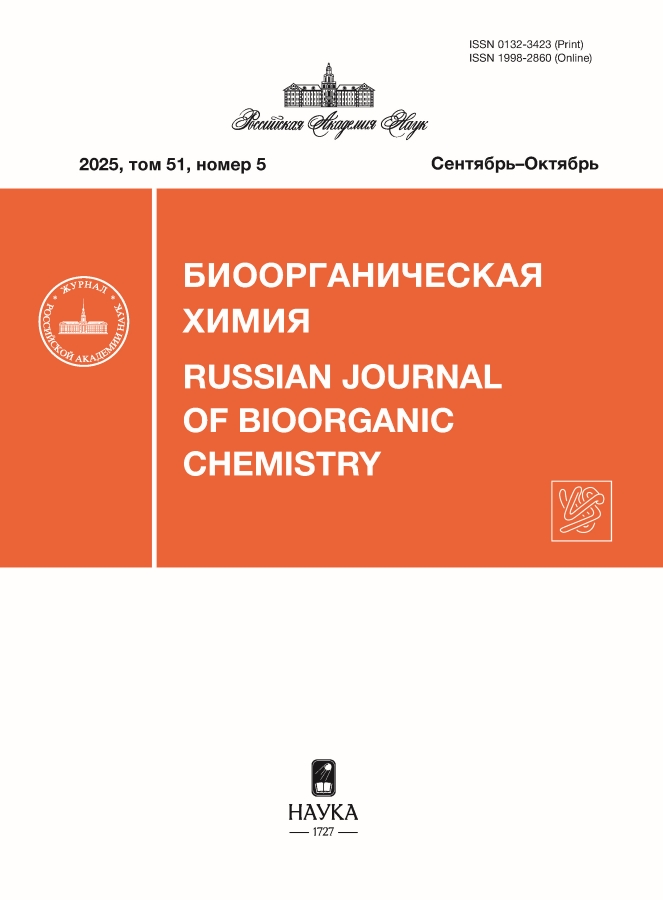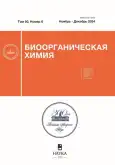The adjuvant effect of benzo(a)pyrene on specific IgE production is linked with the accumulation of germinal center B cells within the spleen and extrafollicular b-cells ativation within the lungs
- Authors: Chudakov D.B.1, Shustova O.A.1, Streltsova M.A.1, Generalov A.A.1, Velichinskii R.A.1, Kotsareva O.D.1, Fattakhova G.V.1
-
Affiliations:
- Shemyakin–Ovchinnikov Institute of Bioorganic Chemistry, RAS
- Issue: Vol 50, No 6 (2024)
- Pages: 842-855
- Section: Articles
- URL: https://gynecology.orscience.ru/0132-3423/article/view/670765
- DOI: https://doi.org/10.31857/S0132342324060106
- EDN: https://elibrary.ru/NEWCLK
- ID: 670765
Cite item
Abstract
Despite a large number of works focused on the search for the mechanisms of formation of IgE-producing B cells, the question of the relative contribution of germinal centers and extrafollicular foci B cells in this process still remains controversial. Of particular interest is the study of the mechanisms of stimulation of the allergic immune response under the influence of air pollutants. The aim of the work was to study the connection between the adjuvant effect of benzo(a)pyrene (BaP) on the production of specific IgE in a novel low-dose allergy model with changes in the subpopulation composition of B-cells in the tissue of the immunization site and secondary lymphoid organs. Antigen without any stimuli was administrated to one group of BALB/c mice for 9 weeks in a low (0.3 μg) dose. BaP was administrated to another group of mice along with antigens at a dose of 4 ng. B-cell subpopulations were analyzed by flow cytometry. BaP significantly stimulated the production of allergen-specific IgG1 at early (3 weeks) time point, and allergen-specific IgE at late (9 weeks) time point. The aeropollutant increased the content of CD19+CD38–CD95+B220+ germinal center B-cells with the phenotype and their precursors (CD19+CD38+CD95+B220+) with the phenotype in the spleen at early and late time points, but not in the lungs or regional lymph nodes. Under its influence, the content of CD19+CD38–CD95+B220– and CD19+CD38+CD95+B220+ extrafollicular plasmablasts in the spleen at an early time point and in lung tissue at a later time point also increases. In the spleen, BaP increased the content of CD138+CD19–B220+ and CD138+CD19–B220– mature plasma cells, and in regional lymph nodes the content of CD138+CD19+B220– immature plasma cells at a later time point. The adjuvant effect of BaP on the production of specific IgE was largely associated with stimulation of the formation of germinal centers in the spleen and with extrafollicular activation of B cells in lung tissue.
Full Text
About the authors
D. B. Chudakov
Shemyakin–Ovchinnikov Institute of Bioorganic Chemistry, RAS
Author for correspondence.
Email: boris-chudakov@yandex.ru
Russian Federation, ul. Miklukho-Maklaya 16/10, Moscow, 117997
O. A. Shustova
Shemyakin–Ovchinnikov Institute of Bioorganic Chemistry, RAS
Email: boris-chudakov@yandex.ru
Russian Federation, ul. Miklukho-Maklaya 16/10, Moscow, 117997
M. A. Streltsova
Shemyakin–Ovchinnikov Institute of Bioorganic Chemistry, RAS
Email: boris-chudakov@yandex.ru
Russian Federation, ul. Miklukho-Maklaya 16/10, Moscow, 117997
A. A. Generalov
Shemyakin–Ovchinnikov Institute of Bioorganic Chemistry, RAS
Email: boris-chudakov@yandex.ru
Russian Federation, ul. Miklukho-Maklaya 16/10, Moscow, 117997
R. A. Velichinskii
Shemyakin–Ovchinnikov Institute of Bioorganic Chemistry, RAS
Email: boris-chudakov@yandex.ru
Russian Federation, ul. Miklukho-Maklaya 16/10, Moscow, 117997
O. D. Kotsareva
Shemyakin–Ovchinnikov Institute of Bioorganic Chemistry, RAS
Email: boris-chudakov@yandex.ru
Russian Federation, ul. Miklukho-Maklaya 16/10, Moscow, 117997
G. V. Fattakhova
Shemyakin–Ovchinnikov Institute of Bioorganic Chemistry, RAS
Email: boris-chudakov@yandex.ru
Russian Federation, ul. Miklukho-Maklaya 16/10, Moscow, 117997
References
- Pouslen L.K., Hummelshoj L. // Ann. Med. 2007. V. 39. P. 440–456. https://doi.org/10.1080/07853890701449354
- Pandya R.J., Solomon G., Kinner A., Balmes J.R. // Environ. Health Prospect. 2002. V. 10 (S1). P. 103–112. https://doi.org/10.1289/ehp.02110s1103
- Munoz X., Barreiro E., Bustamante V., Lopez-Campos J.L., Gonzalez-Barcala F.J., Cruz M.J. // Sci. Total Environ. 2019. V. 652. P. 1129–1138. https://doi.org/10.1016/j.scitotenv.2018.10.188
- Грачев В.А., Ишков А.Г., Романов К.В., Курышева Н.И. // Вестник НИЦ МИСИ. Актуальные вопросы современной науки. 2019. № 18. С. 142–155.
- Wang X., Wang Y., Bai Y., Wang P., Zhao Y. // J. Energy Inst. 2019. V. 92. P. 1864–1888. https://doi.org/10.1016/j.joei.2018.11.006
- Balmes J.R. // Thorax. 2011. V. 66. P. 4–6. https://doi.org/10.1136/thx.2010.145391
- Yanagisawa R., Takano H., Inoue K.-I., Ichinose T., Sadakane K., Yoshino S., Yamaki K., Yoshikawa T., Hayakawa K. // Clin. Exp. Allergy. 2006. V. 36. Р. 386–395. https://doi.org/10.1111/j.1365-2222.2006.02452.x
- Канило П.М., Костенко К.В. // Проблемы машиностроения. 2011. Т. 14. № 6. С. 73–80.
- Ткачева М.В. // Сб. матер. конф. “Актуальные вопросы радиационной и экологической медицины, лучевой диагностики и лучевой терапии”, Гродно, 2022. С. 349–354.
- Малыгина Д.А., Роговская Н.Ю., Бельтюков П.П., Бабаков В.Н. // Токсикологич. вестник. 2022. Т. 30. № 3. С. 158–166.
- Yanagisawa R., Koike E., Win-Shwe T.-T., Ichinose T., Takano H. // J. Appl. Toxicol. 2016. V. 36. P. 1496– 1504. https://doi.org/10.1002/jat.3308
- Yanagisawa R., Koike E., Win-Shwe T.-T., Ichinose T., Takano H. // J. Immunotoxicol. 2018. V. 15. P. 31–40. https://doi.org/10.1080/1547691X.2018.1442379
- Wang E., Liu X., Tu W., Do D.C., Yu H., Yang L., Zhou Y., Xu D., Huang S.-K., Yang P., Ran P., Gao P.-S., Liu Z. // Allergy. 2019. V. 74. P. 1675–1690. https://doi.org/10.1111/all.13784
- Gatto D., Brink R. // J. Allergy Clin. Immunol. 2010. V. 126. P. 898–907. https://doi.org/10.1016/j.jaci.2010.09.007
- Talay O., Yan D., Brightbill H.D., Straney E.E.M., Zhou M., Ladi E., Lee W.P., Egen J.G., Austin C.D., Xu M., Wu L.C. // Nat. Immunol. 2012. V. 13. P. 396– 404. https://doi.org/10.1038/ni.2256
- Yang Z., Sullivan B.M., Allen C.D.C. // Immunity. 2012. V. 36. P. 857–872. https://doi.org/10.1016/j.immuni.2012.02.009
- Basso K., Dalla-Favera R. // Immunol. Rev. 2012. V. 247. P. 172–183. https://doi.org/10.1111/j.1600-065X.2012.01112.x
- Kitayama D., Sakamoto A., Arima M., Hatano M., Miyazaki M., Tokuhisa T. // Mol. Immunol. 2008. V. 45. P. 1337–1345. https://doi.org/1016/j.molimm.2007.09.007
- Barnett B.E., Ciocca M.L., Goenka R., Barnett L.G., Wu J., Laufer T.M., Burkhardt J.K., Cancro M.P., Reiner S.L. // Science. 2012. V. 335. P. 342–344. https://doi.org/10.1126/science.1213495
- Roco J.A., Mesin L., Binder S.C., Nefzger C., GonzalezFigueroa P., Canete P.F., Ellyard J., Shen Q., Robert P.A., Cappello J., Vohra H., Zhang Y., Nowosad C.R., Schiepers A., Corcoran L.M., Toellner K.-M., Polo J.M., Meyer-Hermann M., Victora G.D., Vinuesa C.G. // Immunity. 2019. V. 51. P. 337–350. https://doi.org/10.1016/j.immuni.2019.07.001
- Marshall J.R., Zhang Y., Pallan L., Hsu M.-C., Khan M., Cunningham A.F., MacLennan I.C.M., Toellner K.M. // Eur. J. Immunol. 2011. V. 41. P. 3506–3512. https://doi.org/10.1002/eji.201141762
- Feldman S., Kasjanski R., Poposki J., Hermandez D., Chen J.N., Norton J.E., Suh L., Carter R.G., Stewens W.W., Peters A.T., Kern R.C., Conley D.B., Tan B.K., Shintani-Smith S., Welch K.C., Grammer L.C., Harris K.E., Kato A., Schleimer R.P., Husle K.E. // Clin. Exp. Allergy. 2017. V. 47. P. 457–466. https://doi.org/10.1111/cea.12878
- Corrado A., Ramonell R.P., Woodruff M.C., Tipton C., Wise S., Levy J., DelGaudio J., Kuruvilla M.E., Magliocca K.R., Tomar D., Garimalla S., Scharer C.D., Boss J.M., Wu H., Gumber S., Fulice C., Gibson G., Rosenberg A., Sanz I., Lee F.E.-H. // Mucosal Immunol. 2021. V. 14. P. 1144–1159. https://doi.org/10.1038/s41385-021-00410-w
- Wang Z.-C., Yao Y., Chen C.-L., Guo C.-L., Ding H.-X., Song J., Wang Z.-Z., Wang N., Li X.-L., Liao B., Yang Y., Yu D., Liu Z. // J. Allergy Clin. Immunol. 2022. V. 149. P. 610–623. https://doi.org/10.1016/j.jaci.2021.06.023
- Ramadani F., Bowen H., Gould H.J., Fear D.J. // Front. Immunol. 2019. V. 10. Р. 402. https://doi.org/10.3389/fimmu.2019.00402
- Wu L.C., Zarrin A.A. // Nat. Rev. Immunol. 2014. V. 14. P. 247–259. https://doi.org/10.1038/nri3632
- He S.-J., Subramaniam S., Narang V., Srinivasan K., Saunders S.P., Carbajo D., Wen-Shan T., Hamadee N.H., Lurn J., Lee A., Chen J., Poidinger M., Zolezzi F., Lafaille J.J., de Lafaille M.A.C. // Nat. Commun. 2017. V. 8. Р. 641. https://doi.org/10.1038/s41467-017-00723-0
- Ramadani F., Upton N., Hobson P., Chan Y.-C., Mzinza D., Bowen H., Kerridge C., Sutton B.J., Fear D.J., Gould H.J. // Allergy. 2015. V. 70. P. 1269–1277. https://doi.org/10.1111/all.12679
- Chen Q., Liu H., Luling N., Reinke J., Dent A.L. // J. Immunol. 2023. V. 210. P. 905–915. https://doi.org/10.4049/jimmunol.2200521
- Croote D., Darmanis S., Nadeau K.C., Quake S.R. // Science. 2018. V. 362. P. 1306–1309. https://doi.org/10.1126/science.aau2599
- Gowthaman U., Chen J.S., Zhang B., Flynn W.F., Lu Y., Song W., Joseph J., Gertie J.A., Xu L., Collet M.A., Grassmann J.D.S., Simoneau T., Chiang D., Berin M.C., Craft J.E., Weinstein J.S., Williams A., Eisenbarth S.C. // Science. 2019. V. 365. Р. eaaw6433. https://doi.org/ 10.1126/science.aaw6433
- Asrat S., Kaur N., Liu X., Ben L.-H., Kajimura D., Murphy A.J., Sleeman M.A., Limnander A., Orengo J.M. // Sci. Immunol. 2020. V. 5. Р. eaav8402. https://doi.org/10.1126/sciimmunol.aav8402
- Robinson M.J., Ding Z., Pitt C., Brodie E.J., Quast I., Tarlinton D.M., Zotos D. // Cell Rep. 2020. V. 30. P. 1530–1541. https://doi.org/10.1016/j.celrep.2020.01.009
- Ardavin C., Martin P., Ferrero I., Azcoitia I., Anjuere F., Diggelmann H., Luthi F., Luther S., Acha-Orbea H. // J. Immunol. 1999. V. 162. P. 2538–2545.
- Underhill G.H., Kolji K.P., Kansas G.S. // Blood. 2003. V. 102. P. 4076–4083. https://doi.org/10.1182/blood-2003-03-0947
- Koike T., Fujii K., Kometani K., Butler N.S., Funakoshi K., Yari S., Kikuta J., Ishii M., Kurosaki T., Ise W. // J. Exp. Med. 2023. V. 220. Р. e20221717. https://doi.org/10.1084/jem.20221717
- Pracht K., Meizinger J., Daum P., Schulz S.R., Reimer D., Hauke M., Roth E., Meilenz D., Berek C., Corte-Real J., Jack H.-M., Schuh W. // Eur. J. Immunol. 2017. V. 47. P. 1389–1392. https://doi.org/10.1002/eji.201747019
- Chudakov D.B., Konovalova M.V., Kashirina E.I., Kotsareva O.D., Schevchenko M.A., Tsaregorodtseva D.S., Fattakhova G.V. // Int. J. Environ. Res. Public Health. 2022. V. 19. Р. 13063. https://doi.org/10.3390/ijerph192013063
- Блоцкий А.А., Валова Н.В., Чапленко Т.Н. // Российская ринология. Т. 21. № 2. С. 71–72.
- Chudakov D.B., Kotsareva O.D., Konovalova M.V., Tsaregorodtseva D.S., Schevchenko M.A., Sergeev A.A., Fattakhova G.V. // Vaccines (Basel). 2022. V. 10. Р. 969. https://doi.org/10.3390/vaccines10060969
- de Totero D., Montera M., Rosoo O., Clavio M., Balleari E., Foa R., Gobbi M. // Hematol. J. 2004. V. 5. P. 152–160. https://doi.org/10.1038/sj.thj.6200362
- Vences-Catalan F., Santos-Argumedo L. // IUBMB Life. 2010. V. 63. P. 840–856. https://doi.org/10.1002/iub.549
- Freitag T.L., Fagerlund R., Karam N.L., Leppannen V.-M., Ugurlu H., Kant R., Makinen P., Tawfek A., Jha S.K., Strandin T., Leskinen K., Hepojoki J., Kesti T., Kareinen L., Kuivanen S., Koivulehto E., Sormunen A., Laidinen S., Khattab A., Saavalainen P., Meri S., Kipar A., Sironen T., Vapalahti O., Alitalo K., Yla-Herttuala S., Saksella K. // Vaccine. 2023. V. 41. P. 3233–3246. https://doi.org/10.1016/j.vaccine.2023.04.020
- Ciabattini A., Pettini E., Fiorino F., Prota G., Pozzi G., Medaglioni D. // PLoS One. 2011. V. 6. Р. e19346. https://doi.org/10.1371/journal.pone.0019346
- Rayamajhi M., Delgado C., Condon T.V., Riches D.W., Lenz L.L. // Mucosal Immunol. 2012. V. 5. P. 444–454. https://doi.org/10.1038/mi.2012.21
- Bessa J., Zabel F., Link A., Jegerlehner A., Hinton H.J., Schmitz N., Bauer M., Kundig T.M., Saudan P., Bachmann M.F. // Proc. Natl. Acad. Sci. USA. 2012. V. 109. P. 20566–20571. https://doi.org/10.1073/pnas.1206970109
- Dullaers M., Schuijs M.J., Willart M., Fierens K., van Moorleghem J., Hammad H., Lambrecht B.N. // J. Allergy Clin. Immunol. 2017. V. 140. P. 76–88. https://doi.org/10.1016/j.jaci.2016.09.020
- Samitas K., Malmhall C., Radinger M., RamosRamirez P., Lu Y., Deak T., Semitekolou M., Gaga M., Sjostrand M., Lotvall J., Bossios A. // PLoS One. 2016. V. 11. Р. e0161161. https://doi.org/10.1371/journal.pone.0161161
- Jang E., Cho S., Pyo S., Nam J.-W., Youn J. // Front. Immunol. 2021. V. 12. Р. 631472. https://doi.org/10.3389/fimmu.2021.631472
- Jang E., Cho W.S., Oh Y.-K., Cho M.-L., Kim J.M., Paik D.-J., Youn J. // J. Immunol. 2016. V. 196. Р. 1026–1032. https://doi.org/10.4049/jimmunol.1401059
- Jenkins M.M., Bachus H., Botta D., Schultz M.D., Rosenberg A.F., Leon B., Ballesteros-Tato A. // Sci. Immunol. 2021. V. 6. Р. eabg6895. https://doi.org/10.1126/sciimmunol.abg6895
Supplementary files














